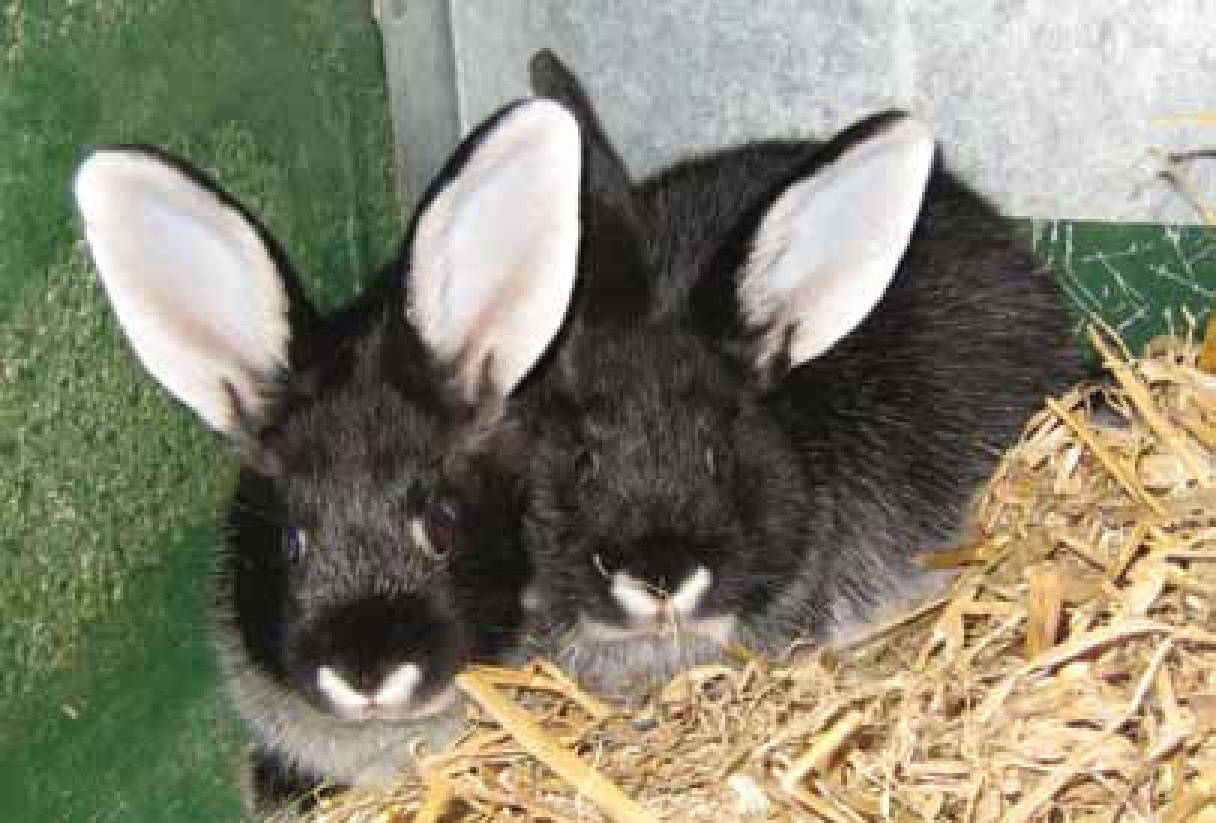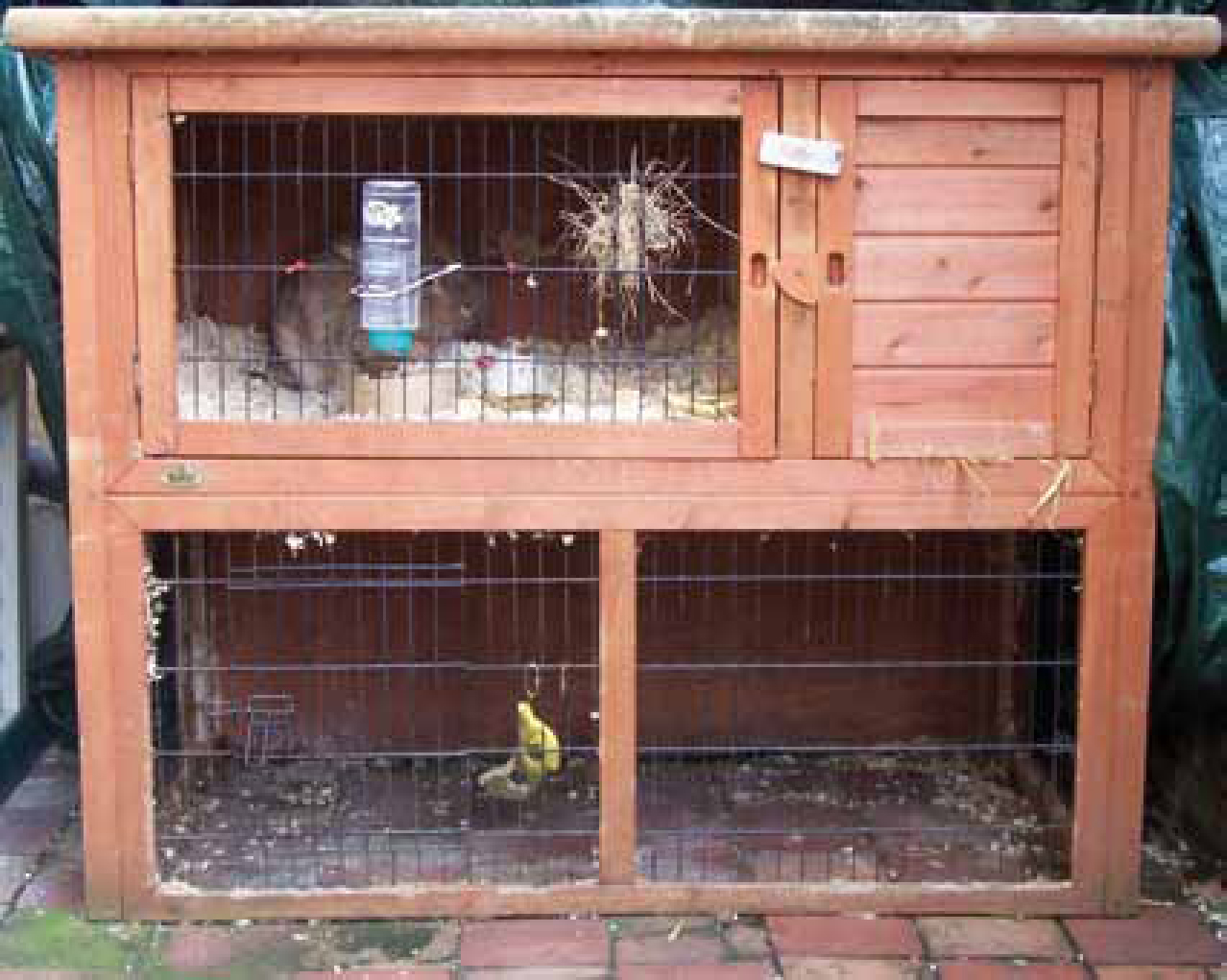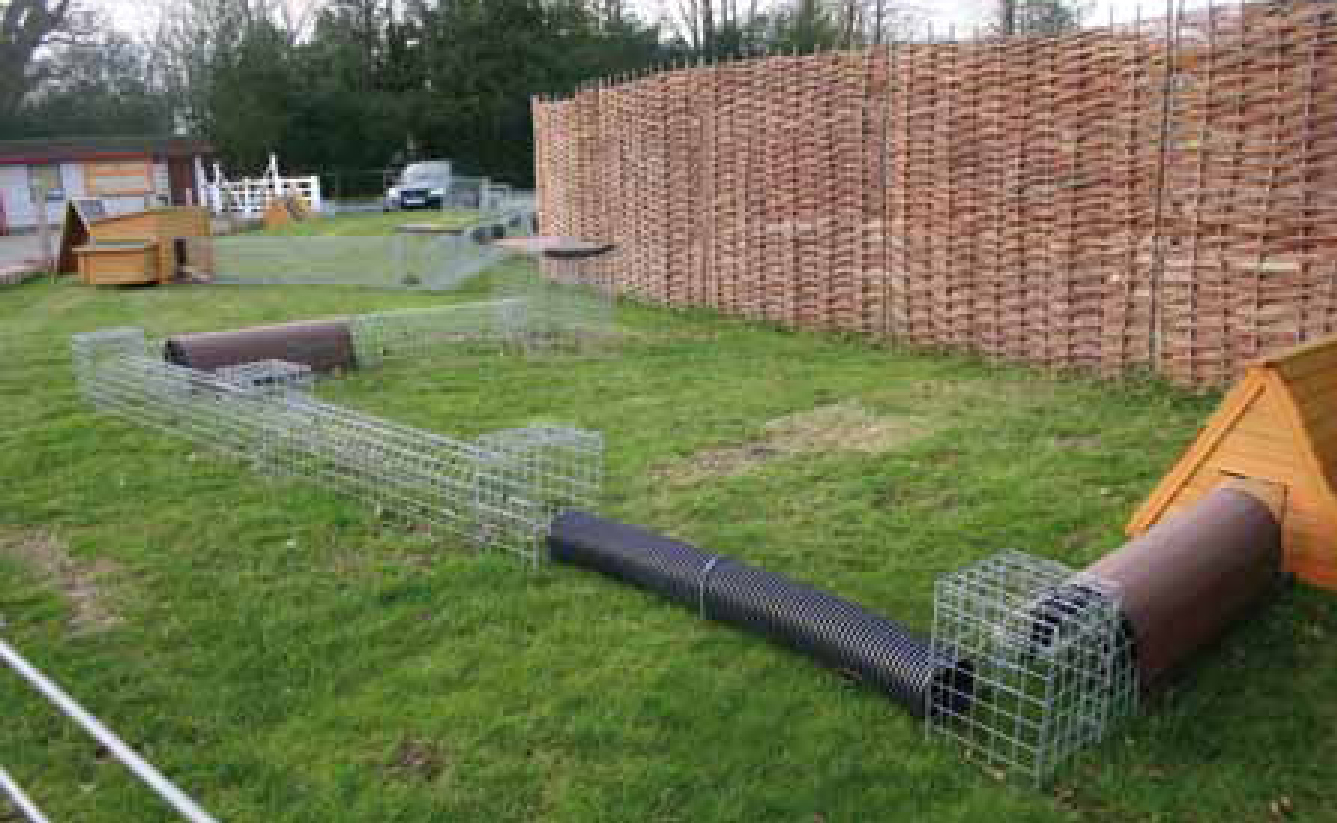Two important factors which must be remembered in rabbit management are that, unlike cats and dogs, rabbits are prey animals, not predators, and also unlike cats and dogs, they have been domesticated for only a relatively short time. They remain very similar to their wild counterparts in their anatomy, physiology, behaviour and psychology, including their social requirements; they will tend to flee, hide or freeze in response to danger, and may sit very still rather than cry out if in pain (Magnus, 2002; Magnus, 2005) (Box 1)
Musculo-skeletal system, visual range and handling
Compared with cats and dogs, rabbits are fragile. They have very powerful hind limb muscles, but their skeleton makes up a relatively low proportion of their bodyweight. In the home, this means that a human tripping over a rabbit, accidentally kicking it, dropping something on it, or shutting it in a door, is much more likely to cause serious injury and fractures (Rich, 2002; Reusche, 2008). Additionally, a rabbit which is picked up and handled incorrectly might kick out with its hind legs and either fall a distance to the ground, which can cause serious injury, or, by kicking out with its powerful hind legs, even fracture its own spine (Keeble, 2002; Reusche, 2008). Rabbits need to be picked up firmly but gently, in a manner that ensures their bodyweight is supported from underneath at all times and so that they cannot kick out or jump away; they can be lifted out of a cage by the scruff but with the other hand under the rump. If placed on a table for examination, they should be given non-slip footing (e.g. a rubber mat, or a towel), and a hand kept on the rabbit's back pushing down slightly to prevent it from jumping off.
Rabbits which are fed on a diet containing inadequate calcium, and those that are not provided with sufficient exercise, may have poor bone mineralization and be prone to fractures (Richardson, 2000).
As a prey species, rabbits have their eyes set into the sides of their head and have a very wide field of vision. However, they cannot see the area just below their chin, therefore to avoid startling them, it is best not to bring a hand up from this area, or touch them there initially.
Rabbits that have not been socialized and introduced to handling at an early age (starting at 10–20 days old) may be very nervous (Magnus, 2005). Their fear reaction may include biting and appear to be aggression; human flinching in response to this startles the rabbit and leads to further fear and more ‘aggressive’ behaviour. Additionally, a rabbit which is in pain may react aggressively to attempted handling.
Both hutch rabbits and house rabbits should be checked daily, including underneath, for any soiling with faeces or urine. Soiled rabbits need careful cleaning as soon as possible to avoid fly strike (Box 2). The problem underlying the soiling must also be addressed. Soiling might indicate urinary incontinence, various physical problems preventing the rabbit eating its caecotrophs (night droppings), or (rarely) true diarrhoea.
Social behaviour
Rabbits are highly social animals, living in family groups in the wild. Most rabbits benefit from the company of one or more other rabbits (and companionship is a requirement under the Animal Welfare Act 2006 (HMSO, 2006). The best way to ensure a compatible pair is to keep two littermates together (Figure 1). However, if one is male and the other female (usually the best pairing), it is important to neuter both rabbits before they reach sexual maturity: as early as 4 to 5 months in the smaller breeds. If this has not been carried out, then they need to be kept apart, but in a manner that allows them to continue seeing and smelling each other, until one or both have been neutered. This may be achieved, for example, by keeping them in side-by-side large wire cages. If separated only by a fence, one might jump over to reach the other (Best, 2008).

Two rabbits that have not been raised together need to be introduced to each other gradually, initially with a barrier between them (e.g. in cages from which they can see, hear and smell each other). A male and a female are most likely to bond well. They should be placed together under supervision, preferably in neutral territory, and with retreats/hiding places such as cardboard boxes available (Anon, 2004). Hay and green foods provide good distraction (not all in one pile). Several introduction sessions may be needed; successful bonding is indicated by mutual grooming and by huddling together (Bradley, 2000). Even bonded rabbits should have provision to get away from each other.
Some pet rabbits do not get on with other rabbits and prefer human company: in effect, the human has become the rabbit's companion. These rabbits may make good solitary house rabbits for someone who wants to bond closely with their rabbit.
It is not uncommon for two rabbits to live together happily until one goes to the veterinary surgery (e.g. to be neutered) and is attacked on its return. This is probably because the returning rabbit smells ‘alien’. To avoid this, both rabbits can go to the veterinary practice together and remain together except during the period of anaesthesia, surgery and initial recovery from anaesthesia. If one rabbit does need to be taken to the veterinary surgery alone, then when it returns it is advisable to cover it with home scents (e.g. by rubbing the rabbit which stayed home with a blanket, then rubbing the returning rabbit with the same blanket) before re-introducing the rabbits (McBride, 2010; Seaman, 2010).
Whether a rabbit can be kept with another species for company depends on both the rabbit and the other animal. A rabbit and a guinea pig can be kept together but the larger rabbit may bully the smaller guinea pig, so provide a retreat the rabbit cannot get into. Rabbits can be kept with some cats and with some dogs (terriers and greyhounds may be harder to socialize to a rabbit); it is advisable to be cautious about leaving a rabbit alone with either cats or dogs (although I knew one medium-sized black-and-white rabbit which lived with four cats, all of whom hunted wild rabbits, and a Labrador retriever, and was perfectly relaxed with them, while it was clear that none of the other animals considered this particular rabbit as potential prey). A rabbit should not be kept with a ferret, a natural predator of rabbits.
Housing
Pet rabbits can be broadly divided into house rabbits and hutch rabbits. Traditionally, a rabbit was a child's pet, kept in a small hutch at the bottom of the garden. It is now recognized that this is inadequate for several reasons.
The traditional hutch is often designed to house only one rabbit, and is often much too small even for a single rabbit (Figure 2). The minimum length for a rabbit hutch should allow the rabbit to perform three hops in a straight line; it should be tall enough to allow the rabbit to stand upright on its hind legs. Additionally, for each rabbit in the hutch there should be a separate sleeping area (so that they can sleep apart if they prefer), with warm, dry bedding such as hay. Rabbits can withstand quite low temperatures, but the hutch should be properly waterproofed so they are kept dry. It is important that the hutch is also shaded from excessive sunlight, as rabbits easily overheat, and from strong winds, although adequate ventilation is important to avoid overheating or respiratory disease (Bourne, 2009a; Anon, 2010). One good solution is to turn a garden shed (on a solid base such as paving slabs, to prevent the rabbit tunnelling out) into a rabbit house, furnished with a litter tray, one or more shelves to lie on or under, and boxes and/or tunnels for the rabbits to hop into and hide in.

Usually a rabbit will choose one place to use as a latrine; this should be cleaned out daily, particularly in summer, and disinfected weekly (using a rabbit-safe disinfectant such as F10 Veterinary Disinfectant, Safe4 disinfectant, or VetArk Ark-Klens) to avoid attracting flies. Any wood preservative must be nontoxic, as wood may be chewed.
House rabbits also need some type of indoor hutch or cage — a space where they can get away from other members of the household and relax. This should be well ventilated (a fish tank is not appropriate), out of direct sunlight and not too near a radiator or other heat source. While rabbits make excellent house pets, it is important to remember that they will chew on practically anything. It is essential to ensure that electrical cables are securely out of reach or covered with rabbit-proof tubing, that poisonous plants (such as African violet, amaryllis, cyclamen, poinsettia and spider plants) are well out of reach, and to recognize that furnishings will get gnawed unless protected. Often, it is most practical to have one fully rabbit-proof room and give access to other rabbit-friendly rooms only under supervision. Rabbits can jump and will jump onto chairs and tables, and will reach items which were considered out of reach; there is a risk of them sliding off a slippery table, knocking a heavy object down on top of themselves, or reaching and gnawing books and magazines. Rabbits can be litter tray trained; it is advisable to provide several litter trays so there is always one near the rabbit, and to make sure they are in places the rabbit will feel safe using them (Best, 2008; Bourne, 2009a).
Exercise
Rabbits need sufficient space to exercise properly. Ideally, a rabbit would have permanent access to a large area of grass on which it could run, jump, graze and dig, but this is often impractical. If the external fence of a garden is rabbit proof (including reaching at least 30 cm (12 inches) underground), and any poisonous plants have been removed or fenced off, the rabbit can have access to the whole garden, under supervision in case of predators — cats, dogs, foxes or even local raptors. Alternatively or additionally, a run can be attached to the hutch or shed/rabbit house, or a moveable run can be used (Bourne, 2009a). Any run must always have a shaded area and a source of water. A new commercially-available system (Runaround — www.runaround.co.uk) uses wire tunnels which the rabbit can run along (Figure 3), providing more scope for exercise than in traditional pens. These runs peg down for safety and attach to one another using special clips; there is an attachment which can lead to/from the hutch (which can also be used between a hutch and a traditional run), and larger connecting boxes where the rabbit can stand upright. The tunnels can be moved to give new areas for grazing.

Environmental enrichment
Whether the rabbit is in the house or is in a hutch, shed, garden, or outdoor run, enrichment should be provided. This includes company (another rabbit and/or human company) and enrichment items (Anon, 2010). These need not be expensive: cardboard boxes, large paper bags, pieces of drain tubing or an old piece of rolled-up carpet make excellent enrichment items. All enrichment items should be non-toxic and either rabbit proof or safe to gnaw on; rabbits should be provided with safe items to gnaw, such as branches from fruit trees. Rabbits should also be given the opportunity to dig. Indoors, a box or child's sandpit containing sand and peat can be provided for digging (Bourne, 2009b).
Food and water
Rabbits are herbivores, designed to eat a high-fibre, relatively low-nutrient diet. Ideally, the bulk of their food should be grass or grass hay. This will help maintain healthy teeth and proper gut function, as well as reducing the risk of obesity. Hay should be supplemented with green food and only a small amount of concentrate food. Clean water should be available at all times; bottles are convenient and harder to spill, but rabbits appear to prefer bowls (Tschudin et al., 2011).
Hospitalization
To minimize stress while hospitalized, rabbits should not be kept where they will be subject to the smell, sound and sight of predators such as cats, dogs, ferrets, or birds of prey (for wild rabbits, add humans to this list). Ideally, they should be kept in a room separate from these species. They should be given somewhere to hide (e.g. a cardboard box), and a towel should be hung over the front door of the cage. Provide a nonslip substrate, plus hay as both bedding and food; hay and water should be available at all times. Check whether the rabbit uses a water bowl or a sipper bottle, as it may not use a water source of an unfamiliar type; it may be easier for a sick rabbit to drink from a bowl. Monitor the room temperature because rabbits easily overheat. While a rabbit may need to be kept warm while it recovers from anaesthesia, it should be observed closely and once conscious should be kept at about 21–23°C (Brown and Goodman, 2006; McBride, 2010). Provide something from home which smells familiar: ideally, their rabbit ‘buddy’, otherwise a familiar blanket or toy. Reducing stress minimizes the risk of the rabbit developing anorexia (Harcourt-Brown, 2002), which is potentially life-threatening. Providing a safe space for daily exercise is beneficial.
Veterinary nurses play a vital role in educating owners about their rabbits, from the basic biological details (Box 1), feeding and housing of rabbits, to the behavioural needs of rabbits(Box 3), and preventing common diseases (e.g. fly strike (Box 2)), Further information is available from www.wildlifeinformation.org (open access from May 25 2011)); from www.rabbitwelfare.org; and the House Rabbit Society (www.rabbit.org).
Conclusions
Rabbits can make very good pets provided their physical features as prey animals, and their behavioural needs, are recognized and allowed for. Rabbits need social companionship, appropriate housing with sufficient room for exercise, and appropriate enrichment. In the home, rooms they have access to must be safely rabbit proofed. Gentle but firm handling is important. Hospitalized rabbits need privacy, a non-slip substrate, familiar scents and access to hay and water.
